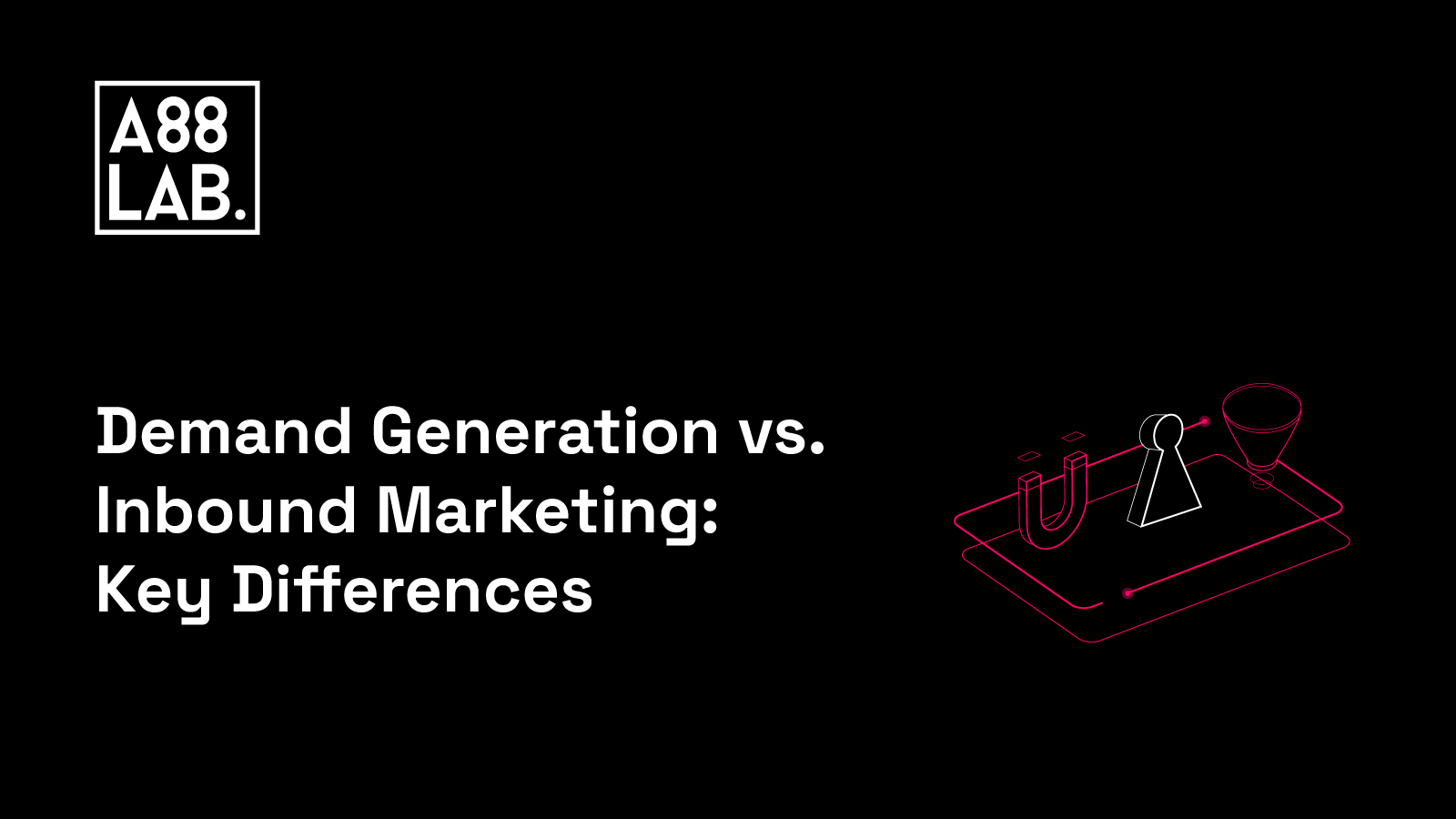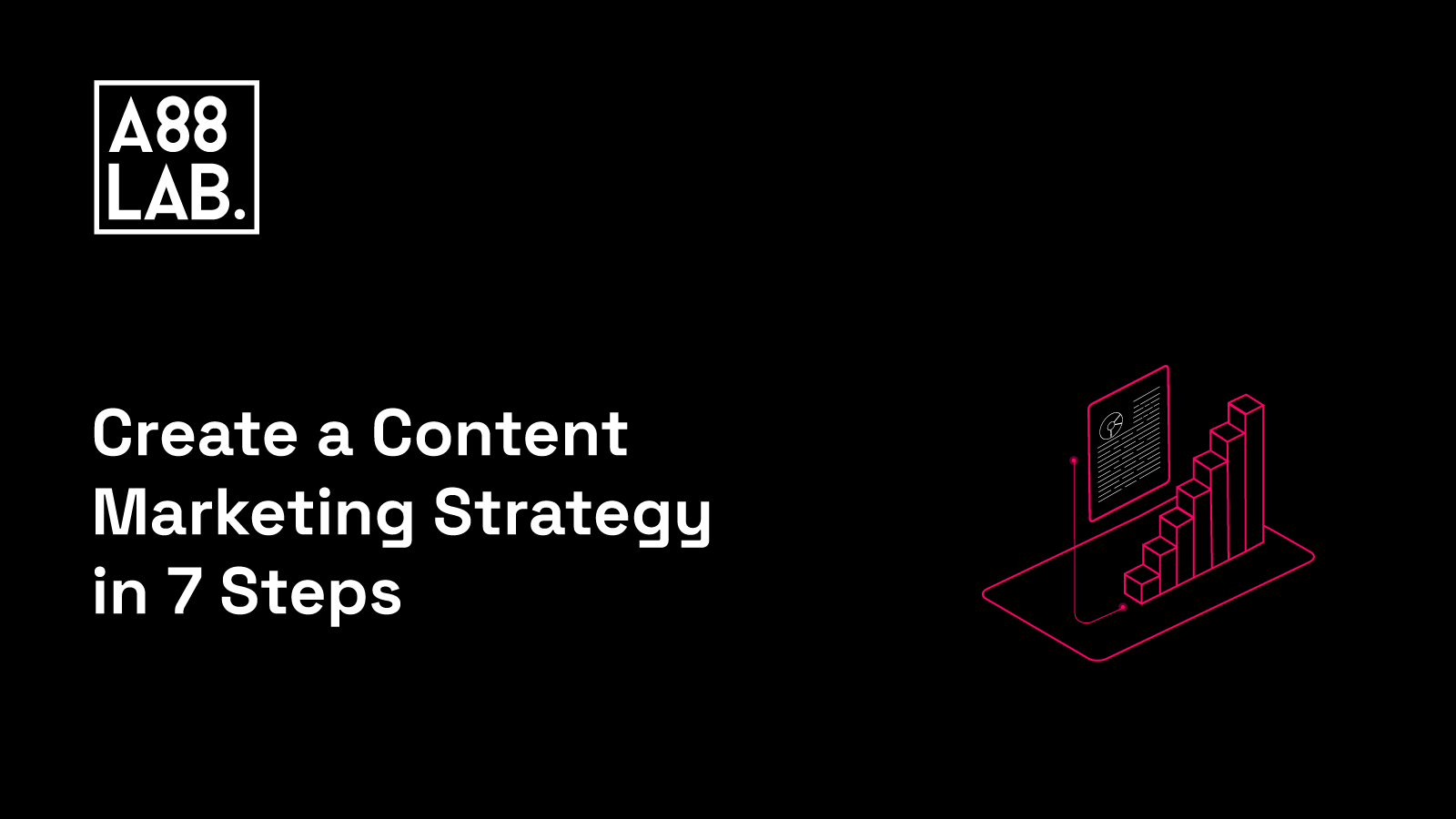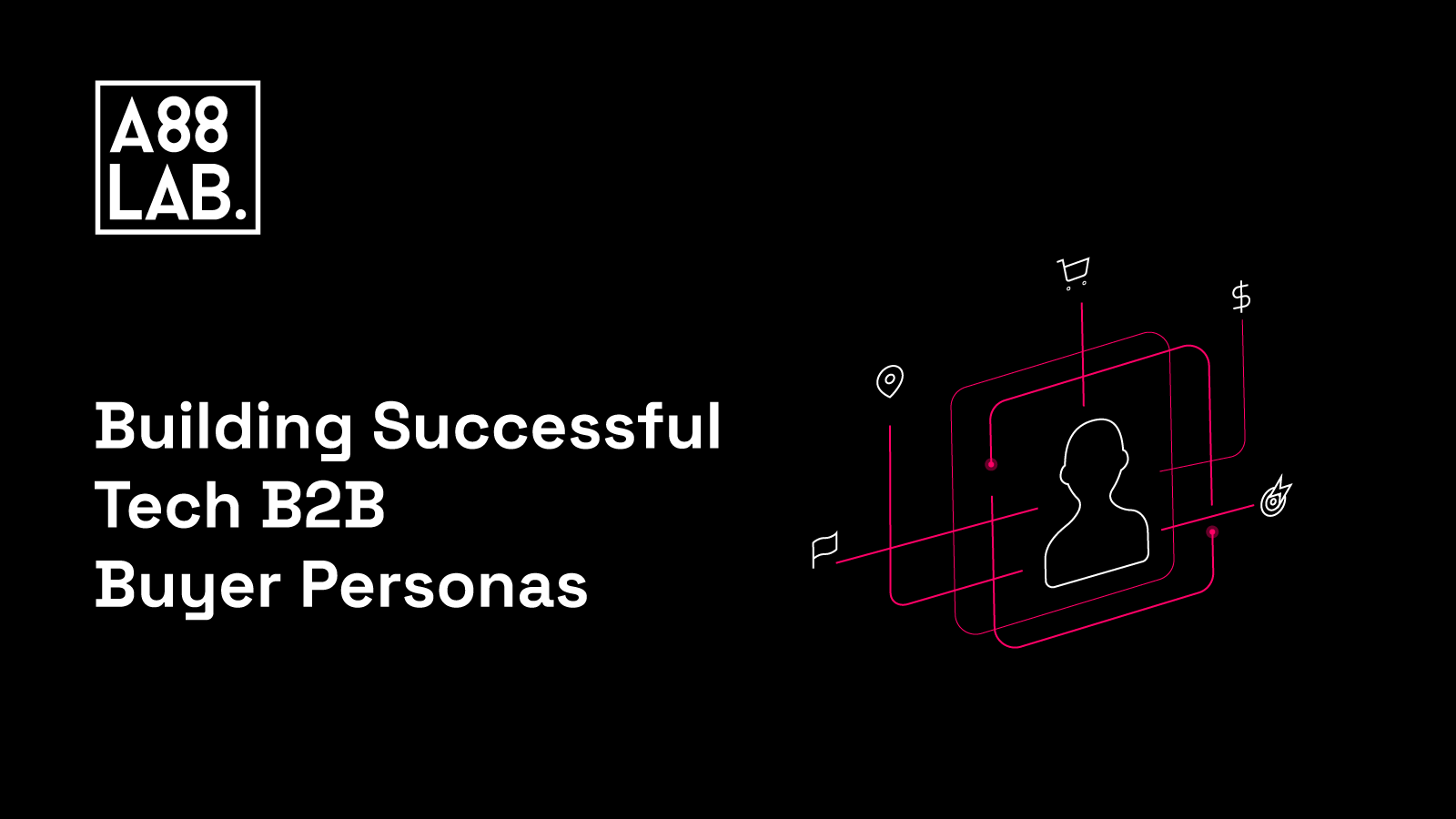You're not alone if you're having trouble keeping different marketing concepts straight. Many professionals use inbound marketing vs demand generation interchangeably.
While both inbound marketing and demand generation help generate high-quality leads and revenue for your business, the two concepts are rather different. Today's article will discuss the key differences between the two of them.
What Is Inbound Marketing?
Customers nowadays are highly conscious of their buying decisions. Before purchasing a specific product, they research and gather all the necessary information. Inbound marketing is a methodology that educates your customers using the information they're looking for.
Moving away from traditional marketing, the idea is to create relevant and valuable content and strategically distribute it through online channels. This way, you will bring knowledge to your prospects while highlighting your expertise.
Inbound marketing is a strong foundation for building your brand reputation and achieving your B2B goals by being helpful and human.
According to Hubspot’s “The 2023 State of Marketing Report”, inbound marketing methods cost 61% less per lead than traditional outbound methods.
You can apply inbound to your marketing strategy by focusing on the following three things:
-
Awareness stage - You should attract your ideal customers with relevant content in this phase.
-
Consideration stage - During the consideration stage, you should guide and engage your prospect in their journey to become customers.
-
Decision stage - Provide your customers an outstanding experience and make them your brand advocates.
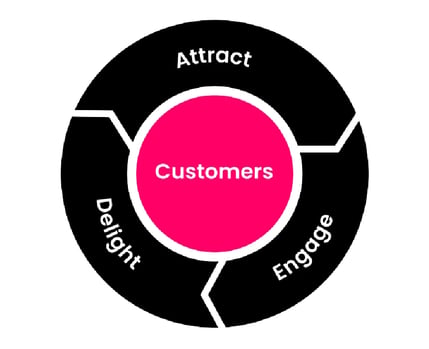
3 Stages of an Inbound Marketing Strategy
The inbound marketing methodology revolves around the idea of creating and distributing relevant and valuable content that addresses the different pain points your target customers are facing. So, instead of chasing your customers and pushing your message to a broad audience through traditional advertising methods, your customers are the ones who are naturally drawn to you.
There are numerous different variations of inbound marketing best practices and inbound marketing services you can start incorporating in your SaaS businesses. Before you start going down that path, the first and most important thing is to truly understand the 3 stages of an inbound marketing strategy that we mentioned before that every SaaS company goes through no matter the industry.
Awareness Stage (Attracting Customers)
The first stage of inbound marketing is all about attracting your target audience and buyer personas through content creation and development. Keep in mind here that even though the customers in this stage may not be strangers to you, you are most likely a stranger to them, so this stage is all about building that brand awareness. The first stage is the one that determines the success of the other two so knowing which tactics you need to implement here is crucial.
Consideration Stage (Engaging Customers)
Once your prospects become familiar with your products the next stage is engaging with them and ultimately converting them into leads. This is where you deliver premium - level content that will help in the decision making processes of your customers. In this stage you need to start prioritizing solution selling over product selling. This approach ensures that all deals result in mutually beneficial agreements for both sides, the customers and your business.
Delight Stage
Give the Delight stage the same amount of time and effort as the first three stages. Just because someone has given you their money doesn't mean you can disappear. Make sure to follow up with your customers on their preferred channels, design your website to be user-friendly for both new visitors and loyal customers, and host events that will delight them. Don't forget to ask for their feedback through surveys and engage with them on social media. While not every brand can become a lifestyle, these practices can help you build customer loyalty. If your customers are happy with your product or service, it’s most likely they will start promoting it for you.
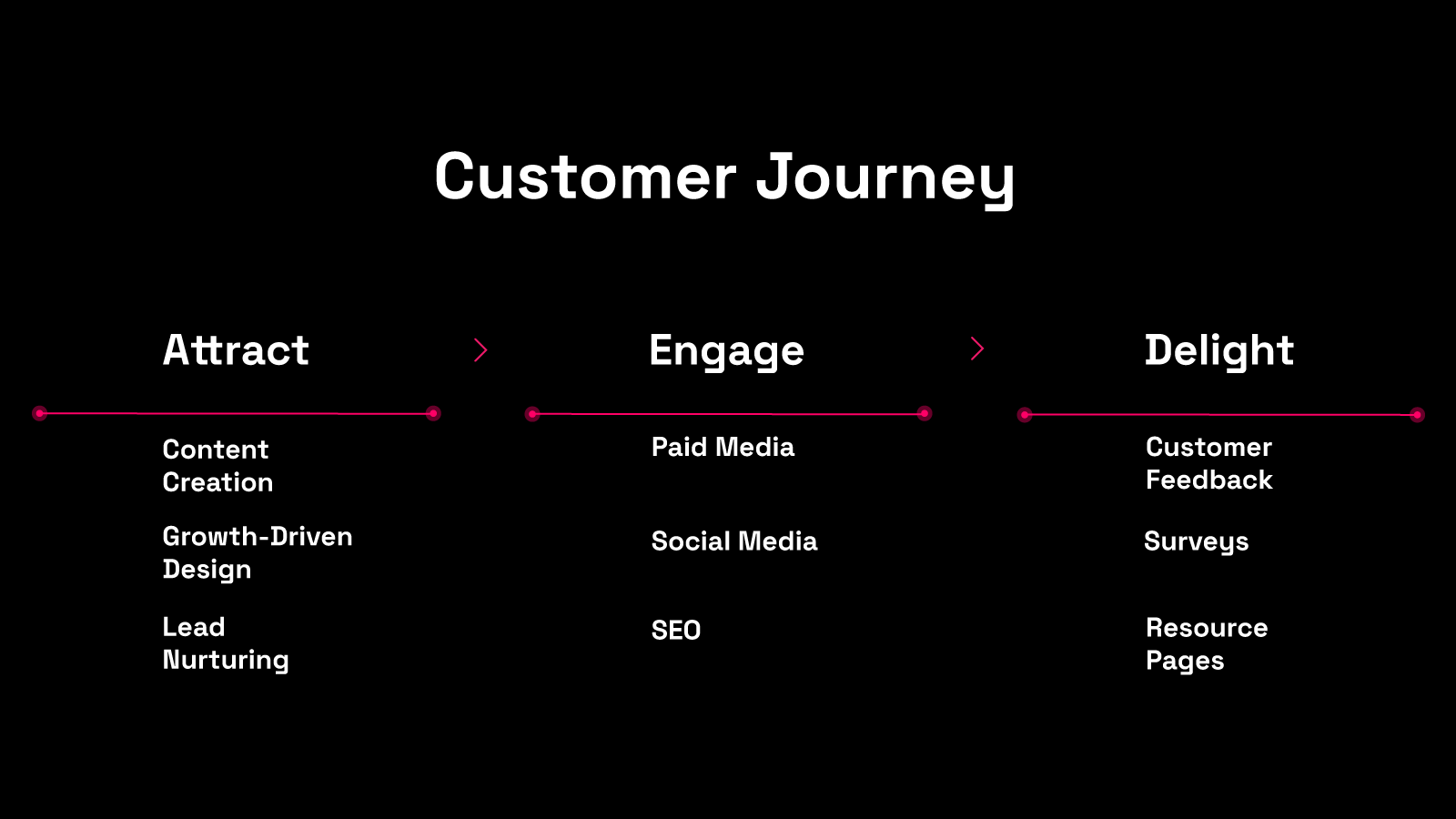
Inbound Marketing Best Practices
When it comes to inbound marketing, have a scalable and repeatable playbook that incorporates best practices to attract ideal buyers to your website, convert website traffic into leads, and ultimately nurture those leads into customers.
Know Your Customers' Pain Points, Motivations And Preferences
Understanding your target audience is key to successful SaaS inbound marketing strategy. This requires defining your ideal customer profile and buyer personas. Your ideal customer profile should outline the characteristics of the prospects who would benefit most from your software, while buyer personas provide a more detailed depiction of the individuals you'll be engaging with. By understanding your potential customers, you will drive traffic to your website and build lasting relationships at the same time.
Build A Strong Website That Drives Sales
No one wants a confusing and inconvenient website, it causes potential buyers to quickly lose interest, resulting in lost sales and revenue.
Avoid this, by designing a website by keeping the user pain points in mind, with clear and cohesive messaging while also enabling a mobile-friendly version. This will end up helping you attract and retain customers, ultimately leading to business growth and success.
Develop Unique And Value-Driven Content For Your Niche
Fully embrace SaaS inbound marketing by creating unique and valuable content that resonates with your target audience. Understand your customer base and develop ungated content that answers their questions and provides targeted information through blogs, videos, e-books, infographics, social media, and more. Do this and establish yourself as a thought leader and authority in your industry. Also, don’t forget about SEO, it will help boost your rankings on Google and make your content easily discoverable, allowing you to reach more potential customers.
Automate Your Processes
With the right marketing automation software, you can effectively manage all internal procedures and communications across various channels. It also equips you with the necessary tools to monitor and evaluate key performance metrics that align with your business objectives. HubSpot and Salesforce, two leading players in the inbound marketing industry, offer beneficial marketing automation platforms and are a great starting point for newcomers to inbound marketing.
What Is Demand Generation?
Demand generation is the process of driving awareness and interest in your product or services. Unlikely Inbound Marketing, where the main goal is to produce educational content for each stage of the buyer's journey, Demand Generation extends beyond content production.
Demand generation uses a lot of different activities, including PPC, SEO, email marketing, and more. It is a mix of marketing techniques (inbound and outbound) integrated into a structured sales process.
.webp?width=635&name=Demand%20gen-01%20(1).webp)
Demand generation aims to:
-
Make your audience aware and interested in your product or service
-
Align your marketing and sales teams
-
Continuously optimize the sales pipeline
-
Generate high-quality opportunities
-
In the past, tech startups implementing demand generation were focused on the volume of leads and how to convert them.
However, the perspective is quickly changing. If you want high-performing demand gen strategies, you need to expand that focus on offering personalized buying experiences, leveraging metrics, and more.
Why Every SaaS Startup Needs a Demand Generation Strategy
To effectively market your SaaS solution to potential clients, educate them about how your product or service can benefit their business. This is where demand generation comes in. The main objectives of a B2B SaaS demand generation strategy are to establish your brand as a leader in the market, generate leads that convert into paying customers, and increase your product's visibility among competitors.
There are a number of reasons why you should incorporate demand generation strategies into your SaaS business, some of the benefits this strategy brings are:
Increase Return of Investment (ROI)
One of the benefits of having a demand generation plan for your SaaS company is that it can lead to a better return on investment. By creating content that specifically appeals to your target audience, you'll increase your conversion rate and be able to identify the most profitable channels for lead generation, allowing you to focus your efforts and boost your ROI.
Expand Brand Awareness
Demand generation also helps with building brand awareness and generating interest in your SaaS product or service. By educating your potential customers, you're increasing the likelihood that they'll remember your brand when it comes time to make a purchase. Generating interest and awareness through inbound marketing can also draw more prospects to your SaaS brand.
Generate More Leads
Although demand generation and lead generation aren't the same thing, a well-executed demand plan should result in more leads for your SaaS company. As more prospects become aware of your brand and its value, they're more likely to engage with you, which can lead to increased sales.
Directs the Sales and Marketing Efforts Toward a Specific Goal.
A demand plan can also help align your sales and marketing efforts toward a common goal for your SaaS company. By focusing on the customer's needs and wants, your company can create better outreach content that helps both teams understand how their efforts fit into the bigger picture of your business.
Establish Your SaaS as a Go-to Resource
Finally, having a demand generation plan can help establish your SaaS business as the go-to resource in your industry, setting you apart from competitors who haven't put as much thought into their marketing strategy.
How to Create a Winning Demand Generation Strategy
When it comes to developing a winning b2b SaaS demand generation strategy, it can be quite of a challenge. You need to have a deep understanding of your target audience, including their pain points, challenges, buying decisions, buying preferences, where they hang out, like communities, groups, channels, what content types they prefer, etc. Based on that, you will need to develop a comprehensive strategy. It's an ongoing process that requires constant optimization and fine-tuning.
Some of the best practices that are proven to deliver great results when it comes to demand generation strategies for SaaS are:
Product-Led Growth
Product-led growth is a business strategy that helps SaaS businesses acquire, activate, and retain customers. Unlike sales-led companies where their main goal is to take customers from point A to point B, the product-led companies goal is to make it easier for users to discover product features and their use cases
To make the product-led growth strategy part of your demand generation strategy you need to:
Prioritize User Friendly Experience
By creating a seamless and efficient onboarding process, potential customers can quickly see the value of the product and be more likely to make a purchase. Additionally, offering a free trial can encourage users to try out the product and potentially convert into paying customers. Ultimately, prioritizing a user-friendly onboarding experience can greatly benefit a business's demand generation efforts.
Offer a Self-Serve Model
By offering a self-serve model for upgrading, businesses can increase demand generation while reducing Customer Acquisition Costs (CAC). Customers are able to upgrade on their own without having to interact with a sales team, making the process more efficient and convenient. This not only saves time and money, but also helps to attract more customers who prefer a self-serve model.
Provide In-Product Education
Provide users with in-product education such as tutorials, tooltips, and guides. By equipping users with the knowledge and resources they need to effectively use your product, you can improve user engagement and retention, ultimately driving demand and growth
A successful PLG strategy requires ongoing effort, including continuous monitoring, adaptation, and a thorough understanding of your users' needs and behaviors. Prioritizing user experience, self-service options, in-product education, and other critical elements can help drive growth and success in the SaaS industry.
Build Online Communities Across Multiple Platforms
Investing in building online communities can help you connect with potential customers and gain valuable insights. These communities are a hub of ideas, opinions, and knowledge that can help you stand out in a crowded market. By engaging in meaningful conversations with members, you can establish your brand as a trustworthy and knowledgeable resource. Here are some tips for leveraging online communities to generate demand:
-
Provide Value First: Instead of focusing on promoting your product or service, prioritize providing value to members. Solve their problems in an authentic and humanized manner, and you'll be able to natively put the word out there about your product or service.
-
Listen to Your Members: Once you've established your community as a valuable space, start asking your members questions about their interests, experiences, and how you can help them. Use polls, surveys, and other interesting ways to entice engagement. By listening to their needs, you can better tailor your product or service to meet their demands.
-
Acknowledge Feedback: Be sure to extend help to members who post issues and complaints. Their feedback is a goldmine of insights that can enhance your reputation and generate demand. Use their feedback to improve your product or service and show potential customers that you value their input.
-
Humanize Your Community: Remember that communities are built for people, so communicate with them like you would in real life. Inject your voice and personality while avoiding business jargon to sound more authentic. By humanizing your community, you can connect with potential customers on a deeper level and generate demand for your product or service.
In conclusion, online communities are a valuable resource for SaaS companies looking to generate demand. By following these tips, you can establish your brand as a trustworthy and knowledgeable resource, connect with potential customers, and stand out in a crowded market.
Offer High-Value Incentive
Consider offering a free high-value incentive to enhance your strategy. This offer should showcase your best work and provide helpful insights into your target audience's business growth. Sharing top-quality content can create buzz around your brand and build trust with your audience. Rather than focusing solely on the features of your SaaS product, focus on selling the overall experience of your solution.
Limited Relevant SaaS Product Information
To pique your prospects' interest, release limited yet essential information about your SaaS product. Provide just enough information to trigger their curiosity. It'll inspire them to do their own research and uncover more about what you offer. This approach is all about sparking that initial interest and leaving them wanting for more. It's the key to capturing your audience's attention and driving demand for your products or services.
Connect With Outsourced Demand-Generation/Sales Partners
Your SaaS team probably consists of mostly tech geeks who are not sales professionals. Outsourcing your sales partners specializing in SaaS demand generation can be beneficial since they have a deep understanding of your target prospects. These individuals know how to capture the attention of your prospects and influence their decision-making process..
Set Up A Lead-To-Revenue Model
Setting up a lead-to-revenue model is crucial for your team to understand when leads typically convert into paying customers and have a strategy in place to nurture those who don't convert right away. This model will help you track and optimize your lead funnel by stage and make it easier to scale later on. Having a solid lead-to-revenue model will ultimately help your business grow and succeed.
Email Drip Campaign
Demand generation doesn’t stop after your prospect signs up for your newsletter. Use drip email campaign strategies that can help nurture your leads. Start with an onboarding email sequence, offer value and content. For engaged prospects, use retargeting with personalized content. Finally, after a demo, highlight the product's value with testimonials, tutorials, or a free trial offer.
Make a Distinction Between Category Creation or Differentiation
Another aspect of demand generation you need to consider is deciding whether to create a new category or differentiate within an existing one.
Category creation refers to the process of creating a new space within a specific market. This goes beyond just introducing a new product or service, and instead involves providing a completely novel way of addressing a problem or fulfilling a need. It requires businesses to offer solutions that go beyond existing category definitions and address customer requirements not met by current offerings.
On the other hand, differentiation involves distinguishing a business's product or service offerings from those of competitors by highlighting unique characteristics, value propositions, or customer experiences. This creates a distinct identity that resonates with target customers and positions the business as the preferred choice within a specific category.
Determining which strategy is right for your SaaS business requires careful assessment of market dynamics, competitive landscape, existing opportunities, and potential risks. Unfortunately, there's no one-size-fits-all solution or playbook to guide you through this process. It's crucial to take the time to make an informed decision.
Demand Generation vs Inbound Marketing
Demand generation and inbound marketing may seem the same, but they are actually quite different from one another. While inbound marketing is a method, demand generation is a function. Demand generation is focused on finding ways to make people feel as though they need your SaaS product for one reason or another. Inbound marketing methodology revolves around creating content that aligns with the needs of your target audience
While inbound marketing falls under the umbrella of demand generation is not the only technique used to attract potential customers. Demand generation also includes outbound marketing, ABM, targeted ads, lead nurturing, and events to convert leads into customers.
To create a successful inbound marketing strategy, engage your audience in a non-disruptive manner that aligns with your demand generation goals. This means creating content that attracts the right buyers, builds trust through educational information, and ultimately leads them to conversion.
It's also worth noting that there's a difference in how leads and content are approached between demand generation and inbound marketing. Demand generation often focuses on ungated content, while inbound marketing uses gated content to capture lead information and nurture them further.
Although they may seem different, inbound and demand generation are complementary tactics that, when used together with other techniques, can help you achieve a successful marketing strategy.
Conclusion
Inbound marketing and demand generation have a common goal: generating interest in your solution and growing your business. Both of these techniques aim to create quality relationships with your customers, which you can sustain over the long term.
Because the goals of inbound marketing and demand generation are similar, you can easily mistake one for the other. However, treating these two approaches as one can take a toll on your marketing and sales efforts.
To sum everything up, inbound marketing is just one component of a comprehensive demand generation strategy.
Even though you will significantly benefit from leveraging inbound marketing in your demand-generation activities, there are also other ways you can create demand for your business.
Want to know more about inbound marketing and demand generation? Go to our blog and find some insightful tips to help your business grow!
.png)
